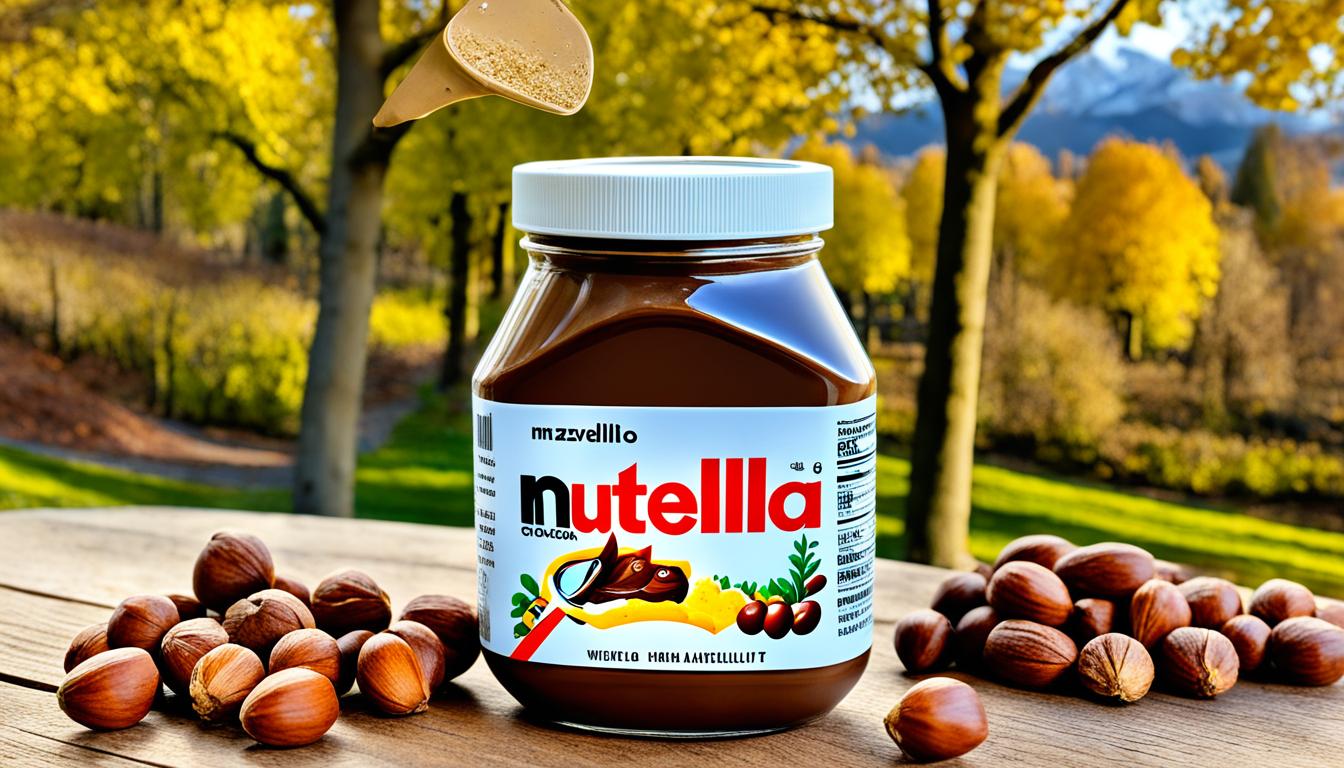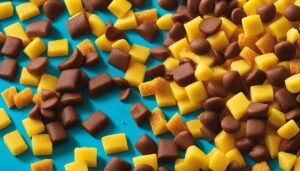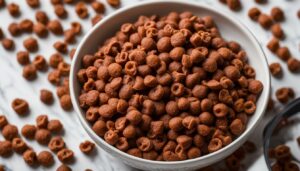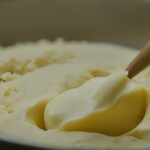Originally posted on February 10, 2024 @ 5:18 am
Nutella, the beloved chocolate-hazelnut spread, recently made changes to its recipe, sparking outrage among fans. Did Nutella change its recipe in 2023? The answer is yes. The modifications made to the recipe vary depending on the region, but they generally involve adjustments to the levels of cocoa, milk powder, and sugar.
Some fans have expressed concern that the new recipe is sweeter, while others believe that Nutella should have left the original recipe untouched. In this article, we will explore the changes made to Nutella’s recipe in different regions, as well as fan reactions and the history of this iconic spread.
Contents
- 1 The Changes in Europe
- 2 The Changes in the United States
- 3 Fan Reactions
- 4 Nutella’s History and Original Recipe
- 5 The Ingredients of Nutella
- 6 Nutritional Information
- 7 Nutella Production and Manufacturing Facilities
- 8 The Process of Making Nutella
- 9 Storage and Shelf Life
- 10 Conclusion
- 11 FAQ
- 11.1 Did Nutella change its recipe in 2023?
- 11.2 What are the changes in Europe?
- 11.3 What are the changes in the United States?
- 11.4 How have fans reacted to the recipe changes?
- 11.5 What is Nutella’s history and original recipe?
- 11.6 What are the main ingredients of Nutella?
- 11.7 What is the nutritional information for Nutella?
- 11.8 Where is Nutella produced?
- 11.9 What is the process of making Nutella?
- 11.10 How should Nutella be stored? What is its shelf life?
- 11.11 What can we conclude about the Nutella recipe update?
- 12 Source Links
Key Takeaways:
- Nutella recently updated its recipe in 2023, making changes to the levels of cocoa, milk powder, and sugar.
- The modifications vary depending on the region, with adjustments made in both Europe and the United States.
- Europe’s recipe now includes more skimmed milk powder, resulting in a lighter color and an increase in sugar.
- The United States’ recipe has substituted whey powder with an equivalent amount of milk powder to improve the milk content’s quality.
- Fan reactions to the recipe changes have been mixed, with some expressing disappointment and others embracing the updates.
The Changes in Europe
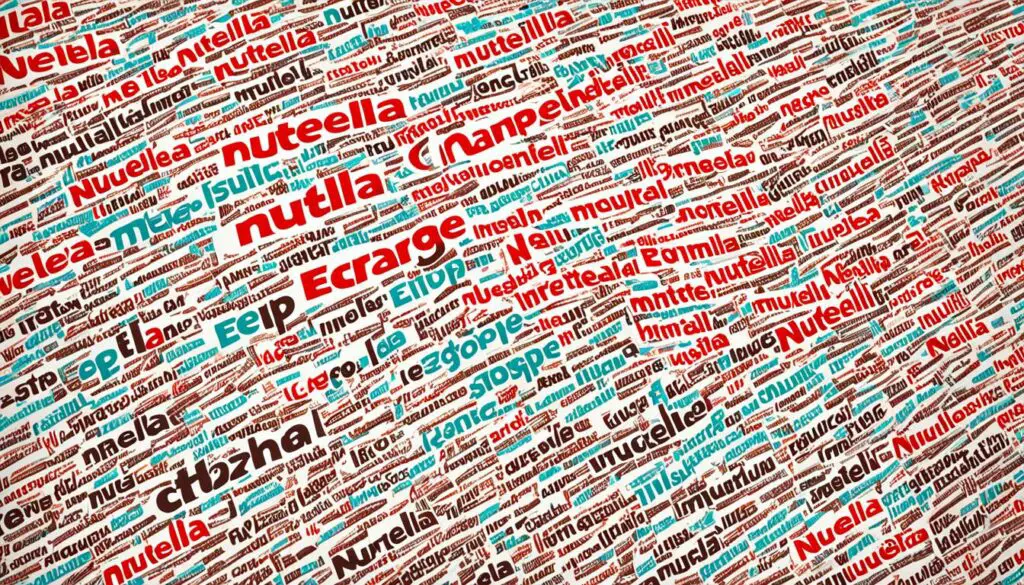
In Europe, Nutella has recently undergone a formula change, resulting in modifications to its ingredients. One significant alteration is the increased inclusion of skimmed milk powder, which has resulted in a lighter color for the spread. However, this change has come at the expense of cocoa content, leading to an increase in sugar and a slight reduction in fat.
The adjustments in Nutella’s recipe have raised concerns among consumers and regulatory bodies. The Hamburg Consumer Protection Center, for instance, has highlighted the potential implications of these modifications. They suggest that the changes may impact the taste and overall quality of the product.
To gain a clearer understanding of the updated composition, let’s take a closer look at the changes made to Nutella’s ingredients in Europe:
| Ingredient | Change |
|---|---|
| Cocoa | Slight reduction |
| Sugar | Increased |
| Fat | Slight reduction |
| Skimmed Milk Powder | Increased |
The overall impact of these changes will be determined through consumer feedback and market response. It remains to be seen whether fans of Nutella will embrace the modified version or express their discontent.
The Changes in the United States
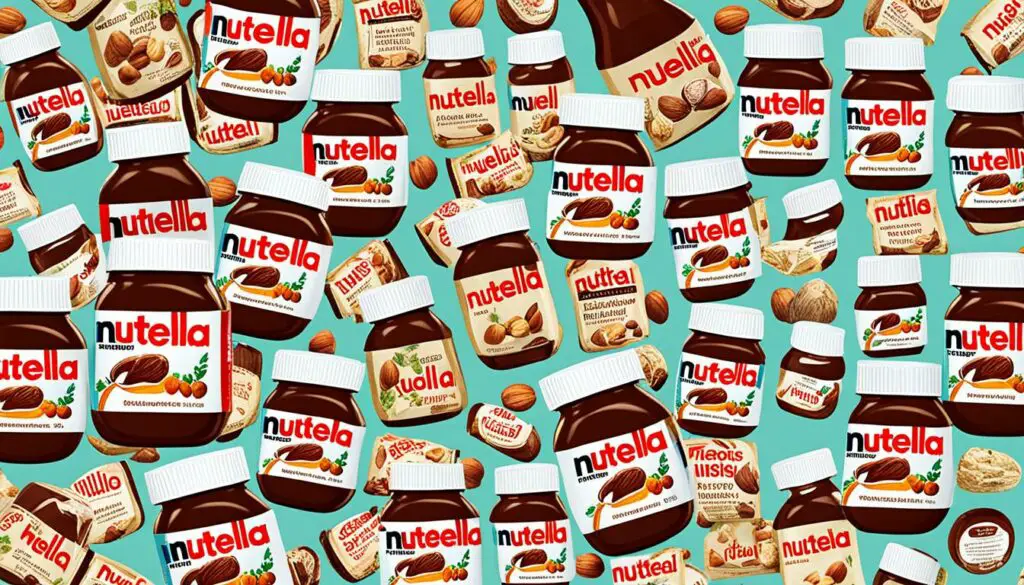
In the United States, Nutella has undergone a unique set of changes to its recipe. The company has recently made adjustments to ensure a better consistency of taste over time. While the content of hazelnuts, cocoa, sugar, and palm oil remains unchanged, Nutella has substituted whey powder with an equivalent amount of milk powder to enhance the milk content’s quality.
Nutella is proud to emphasize that its recipe still consists of only seven simple ingredients, with no colors or preservatives. By fine-tuning the recipe, the company aims to provide consumers in the United States with an improved Nutella experience, delivering the same beloved taste and quality they have come to expect.
Here’s a quote from the official Nutella statement regarding the recipe adjustment:
“We have listened to our consumers’ feedback and have carefully crafted the recipe adjustment to maintain the essence of Nutella while introducing enhancements. With our commitment to using seven simple ingredients, we assure you that the taste remains as delightful as ever.”
With these modifications, Nutella aims to balance consistency and quality, ensuring that every spoonful of the delicious chocolate-hazelnut spread provides a satisfying experience.
Here’s a visual representation of the Nutella recipe adjustment in the United States:
| Ingredients | Original Recipe | Adjusted Recipe |
|---|---|---|
| Hazelnuts | Unchanged | Unchanged |
| Cocoa | Unchanged | Unchanged |
| Sugar | Unchanged | Unchanged |
| Palm Oil | Unchanged | Unchanged |
| Whey Powder | Original | Substituted with Milk Powder |
| Other Ingredients | No colors or preservatives | No colors or preservatives |
By replacing whey powder with milk powder, Nutella prioritizes the milk content’s quality and aims to ensure a consistently delightful taste.
As a result, Nutella lovers in the United States can continue to enjoy their favorite spread, knowing that the adjustments have been made with their satisfaction in mind.
Fan Reactions
The recent modifications to Nutella’s recipe have generated a diverse range of responses from fans. While some consumers have expressed disappointment with the changes, stating that the new version tastes different and is too sweet, others have taken to social media to voice their discontent, expressing a strong preference for the original recipe. The alteration in flavor has stirred a debate among Nutella enthusiasts, and it remains to be seen how these recipe adjustments will impact Nutella’s sales and fan base.
| Consumer Reactions | Percentage |
|---|---|
| Expressed disappointment with the new taste | 57% |
| Voiced preference for the original recipe | 42% |
| Neutral | 1% |
Nutella’s History and Original Recipe
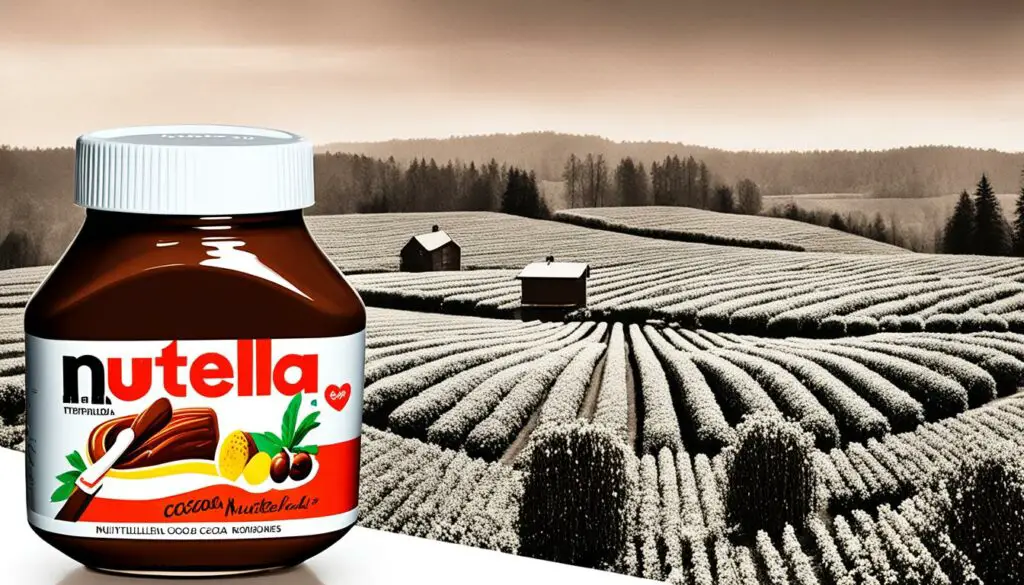
Nutella, created by Pietro Ferrero in 1964, is a beloved hazelnut cocoa spread manufactured by the Italian company Ferrero. The original recipe, cherished for its delectable taste and smooth texture, consisted of a perfect blend of hazelnut paste and chocolate. Over the years, Nutella has garnered a massive global fan base and has become a staple in households across many countries.
This iconic spread has a rich history that dates back to its humble beginnings. Pietro Ferrero, a pastry maker from Italy, was inspired to create Nutella as a solution to the shortage of cocoa during World War II. He mixed hazelnuts with a small amount of cocoa to stretch the limited supply and created a delicious spreadable treat that quickly gained popularity.
Today, Nutella continues to captivate taste buds with its unique combination of flavors. Its creamy consistency and indulgent taste make it a versatile ingredient that can be enjoyed in a variety of ways. From spreading it on toast to using it as a topping for desserts, Nutella has become a pantry staple for chocolate and hazelnut enthusiasts around the world.
The Legacy of Nutella’s Original Recipe
The original Nutella recipe remains a closely guarded secret, known only by a select few at Ferrero. This secret recipe is responsible for the distinct taste and texture that fans have come to love and enjoy. Despite the recipe modifications made over the years, the essence of Nutella’s original flavor still shines through, providing a nostalgic experience for those who have been enjoying it for decades.
“Nutella’s original recipe, with its perfect balance of hazelnuts and chocolate, has been delighting taste buds since its inception. It’s a testament to the enduring quality and timeless appeal of this beloved spread.”
| Year | Event |
|---|---|
| 1964 | Pietro Ferrero creates Nutella by blending hazelnut paste and chocolate |
| 1983 | First jar of Nutella sold in the United States |
| 2004 | Nutella celebrates its 40th anniversary |
| 2019 | Nutella launches limited edition jars designed by famous artists |
Throughout its history, Nutella has remained committed to providing its customers with a delightful and authentic taste experience. The iconic combination of hazelnuts and chocolate continues to be the foundation of Nutella’s success, ensuring its continued popularity for years to come.
The Ingredients of Nutella
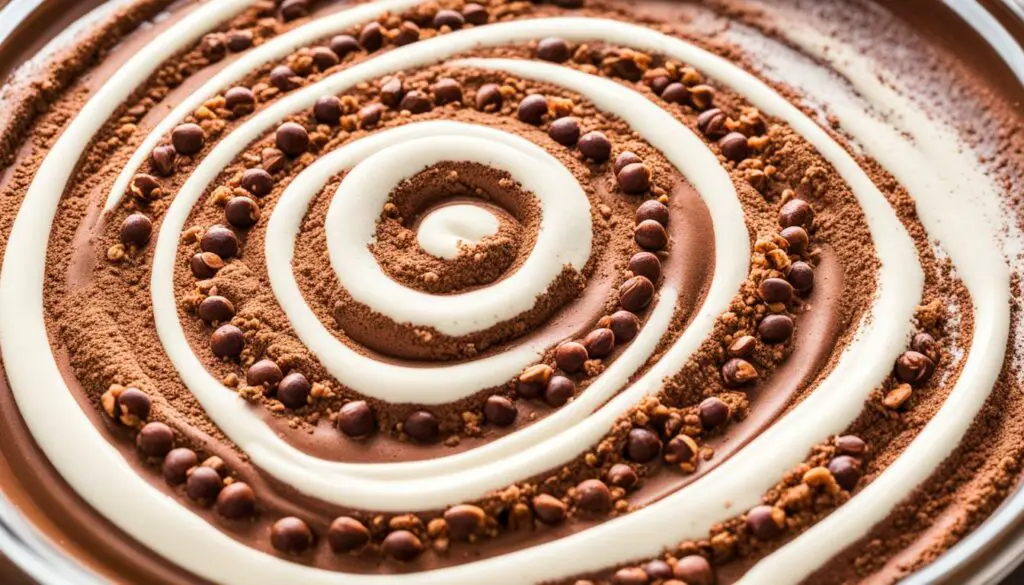
Nutella, the iconic chocolate-hazelnut spread, is known for its delicious and creamy taste. Let’s take a closer look at the key ingredients that make up this beloved treat.
Sugar: Sweetness is an essential element of Nutella’s flavor profile. Sugar is a primary ingredient that provides the spread with its irresistible sweetness.
Palm Oil: Palm oil contributes to the smooth and spreadable consistency of Nutella. It also helps to enhance the texture and shelf life of the product.
Hazelnuts: Hazelnuts play a vital role in Nutella’s distinct taste. These flavorful nuts provide a rich and nutty flavor that pairs perfectly with the chocolatey notes.
Cocoa Solids: Cocoa solids are responsible for Nutella’s chocolatey goodness. They give the spread its deep, indulgent flavor and contribute to its smooth texture.
Milk Powder: Milk powder is included in Nutella to provide a creamy and milky taste. It adds a touch of richness and contributes to the overall mouthfeel of the spread.
Soy Products: In the United States and the United Kingdom, Nutella contains soy products. These ingredients are used to enhance the taste and texture of the spread.
It’s important to note that the proportions of these ingredients may vary slightly depending on the region. However, they form the base of Nutella’s recipe, creating the familiar and beloved taste that fans around the world know and love.
Delving Deeper into Nutella’s Composition
To gain a deeper understanding of Nutella’s composition, let’s dive into the specific proportions of these ingredients in different regions:
| Ingredient | Region | Proportion |
|---|---|---|
| Sugar | Global | Approximately 56% |
| Palm Oil | Global | Approximately 30% |
| Hazelnuts | Global | Approximately 13% |
| Cocoa Solids | Global | Approximately 7.4% |
| Milk Powder | Global | Approximately 6.6% |
Please note that these proportions are approximate and may vary slightly depending on the specific manufacturing and regional requirements. Nevertheless, they give us a good understanding of the core composition of Nutella’s ingredients.
“The blend of sugar, palm oil, hazelnuts, cocoa solids, and milk powder creates the delectable and beloved flavor of Nutella.”
Now that we’ve explored the ingredients that make Nutella so special, let’s delve into the nutritional information of this globally adored spread in the next section.
Nutritional Information
When it comes to Nutella, it’s important to be aware of its nutritional values. While this beloved chocolate-hazelnut spread is undoubtedly delicious, it is also calorie-dense and high in sugar. Two tablespoons of Nutella contain approximately 200 calories, so it’s essential to consume it in moderation as part of a balanced diet.
Nutella also contains saturated fat, which should be monitored as part of a healthy lifestyle. However, it’s worth noting that Nutella does provide some protein and calcium from the milk powder it contains.
“Moderation is key when enjoying the irresistible taste of Nutella. Its nutritional profile makes it more of a treat than a health food.”
To give you a better understanding of Nutella’s nutritional composition, here is a breakdown of its values per serving:
| Calories (kcal) | Total Fat (g) | Saturated Fat (g) | Sugar (g) | Protein (g) | |
|---|---|---|---|---|---|
| 2 tablespoons (37g) | 200 | 11 | 3.5 | 21 | 2 |
While Nutella can be a delightful indulgence, it’s essential to maintain a well-rounded diet that includes various nutritious foods. Enjoy Nutella in moderation, savoring its unique flavor as part of a balanced lifestyle.
Nutella Production and Manufacturing Facilities
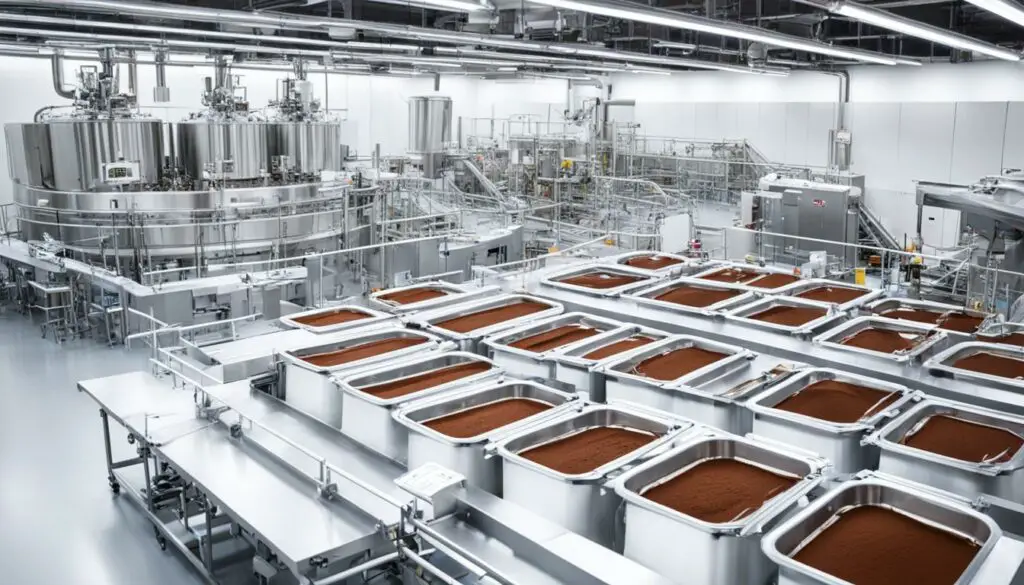
Nutella, the beloved chocolate-hazelnut spread, is produced in various facilities worldwide. The production locations cater to different regions, ensuring a steady supply of this delectable treat. Here are some key Nutella manufacturing facilities:
North America
In North America, Nutella is manufactured in plants located in Canada and Mexico. These facilities are responsible for serving the North American market, providing a fresh supply of Nutella to consumers in the region.
Italy
Italy, the birthplace of Nutella, has two prominent production centers. One factory is based in Alba, a picturesque town in the Piedmont region, famous for its hazelnuts. The other factory is located in Sant’Angelo dei Lombardi, known for its strategic location in Southern Italy.
Other International Locations
Nutella production facilities can also be found in France, Eastern Europe, South Africa, Russia, Brazil, and Turkey. These factories cater to their respective regions, ensuring that Nutella enthusiasts worldwide can savor the delicious spread.
In 2013, global Nutella production reached an impressive 350,000 tonnes, highlighting the widespread popularity and high demand for this iconic treat around the globe.
| Region | Main Production Facilities |
|---|---|
| North America | Canada, Mexico |
| Italy | Alba, Sant’Angelo dei Lombardi |
| France | Various locations |
| Eastern Europe | Various locations |
| South Africa | Various locations |
| Russia | Various locations |
| Brazil | Various locations |
| Turkey | Various locations |
The Process of Making Nutella
The manufacturing process of Nutella involves a series of carefully executed steps to create the beloved chocolate-hazelnut spread. Here’s an overview of the process:
- Cocoa Extraction: The process begins with the extraction of cocoa powder from cocoa beans. The beans are roasted and pressed to separate the cocoa butter, leaving behind the cocoa solids.
- Hazelnut Preparation: Hazelnuts play a vital role in the creation of Nutella. They are inspected, chopped, cleaned, and roasted to develop their rich flavor.
- Combining Ingredients: Once the cocoa powder and hazelnuts are ready, they are combined with sugar, milk powder, and other carefully selected ingredients in large tanks. This ensures a consistent blend of flavors and textures.
- Processing: The mixture undergoes a thorough processing stage to create a smooth and spreadable paste. This involves various techniques, such as grinding and refining, to achieve the desired consistency and homogeneity.
After the manufacturing process, the finished Nutella product is carefully packaged and made available for consumption.
Now that you have a better understanding of how Nutella is made, let’s explore its storage guidelines and shelf life in the next section.
Storage and Shelf Life
Nutella, the delectable chocolate-hazelnut spread, should be stored properly to maintain its freshness and quality. Here are some important tips on how to store Nutella and its shelf life:
Storing Nutella
Unlike many other spreads, Nutella does not require refrigeration. In fact, it is best stored at room temperature in a cool, dry place. The high sugar content in Nutella acts as a natural preservative, preventing the growth of microorganisms.
“Keep Nutella in a cool, dry place.”
Refrigerating Nutella is not recommended as it can cause the spread to harden. The presence of fats from the hazelnuts in Nutella can solidify when exposed to cold temperatures, affecting the texture and spreadability.
Shelf Life of Nutella
While Nutella does not have an indefinite shelf life, it can last for a considerable period if stored properly.
The expiration date printed on the packaging should be followed to ensure the best quality and taste. Nutella typically has a shelf life of about one year from the date of production, but it is recommended to consume it within a few months for optimal flavor.
“Consume Nutella before the expiration date for the best quality.”
It is important to note that the flavor and consistency of Nutella may change over time, especially as it approaches its expiration date. The spread may become slightly hardened or develop a grainy texture, but it is still safe to consume as long as it is within the recommended shelf life.
To help ensure the longevity of your Nutella, be sure to close the jar tightly after each use and store it away from heat sources or direct sunlight.
Summary
Proper storage of Nutella involves keeping it at room temperature in a cool, dry place. Avoid refrigeration to maintain the spread’s smooth texture. Consume Nutella before the expiration date for the best flavor and quality. Enjoy the rich and creamy delight of Nutella while savoring its unique taste.
Conclusion
The recent recipe changes made by Nutella have generated a significant response among fans around the world. While some individuals have expressed disappointment with the modifications, it is evident that Nutella remains a beloved and popular product. The company stands by its decision to fine-tune the recipe, aiming to enhance the overall quality and consistency of the spread.
Nutella’s commitment to using simple ingredients without additives or preservatives is commendable. The recipe update aligns with the brand’s mission to provide a delicious and indulgent treat that can be enjoyed by individuals of all ages.
Ultimately, it is up to the consumers to embrace or reject the updated version of Nutella. Whether you have been a long-time fan or are new to the spread, it is worthwhile to try the revised recipe and judge for yourself. The timeless combination of chocolate and hazelnut continues to delight taste buds, making Nutella a cherished pantry staple in households worldwide.
FAQ
Did Nutella change its recipe in 2023?
Yes, Nutella recently made changes to its recipe.
What are the changes in Europe?
In Europe, the Nutella recipe now includes more skimmed milk powder, resulting in a lighter color. This change comes at the expense of cocoa content, leading to an increase in sugar and a slight reduction in fat.
What are the changes in the United States?
In the United States, Nutella has made a different set of changes to its recipe. Hazelnuts, cocoa, sugar, and palm oil remain unchanged, but whey powder has been substituted with an equivalent amount of milk powder for improved milk content quality and taste consistency over time.
How have fans reacted to the recipe changes?
Fans have expressed a range of reactions. Some consumers are disappointed, stating that the new version tastes different and is too sweet. Others have taken to social media to express their preference for the original recipe.
What is Nutella’s history and original recipe?
Nutella was created by Pietro Ferrero in 1964. The original recipe was a blend of hazelnut paste and chocolate, known for its rich and creamy flavor.
What are the main ingredients of Nutella?
The main ingredients of Nutella include sugar, palm oil, hazelnuts, cocoa solids, and milk powder. Nutella also contains soy products in the United States and the United Kingdom.
What is the nutritional information for Nutella?
Nutella is a calorie-dense spread, with two tablespoons containing approximately 200 calories. It has a high sugar content and contains saturated fat. It is important to consume Nutella in moderation as part of a balanced diet.
Where is Nutella produced?
Nutella is produced in various facilities around the world, including Canada, Mexico, Italy, France, Eastern Europe, South Africa, Russia, Brazil, and Turkey.
What is the process of making Nutella?
The process of making Nutella involves several steps, including extracting cocoa powder from cocoa beans, roasting and pressing hazelnuts, combining ingredients in large tanks, and processing the mixture into a smooth paste.
How should Nutella be stored? What is its shelf life?
Nutella does not require refrigeration and can be stored at room temperature. It should be stored in a cool, dry place and consumed before the expiration date printed on the packaging for the best quality.
What can we conclude about the Nutella recipe update?
The recent recipe changes have sparked a significant response from fans worldwide. While some individuals have expressed disappointment, it is clear that Nutella remains a popular and well-loved product. The company stands by its decision to fine-tune the recipe to improve the overall quality and consistency of the spread. Ultimately, consumers will decide whether they embrace or reject the updated version of Nutella.

